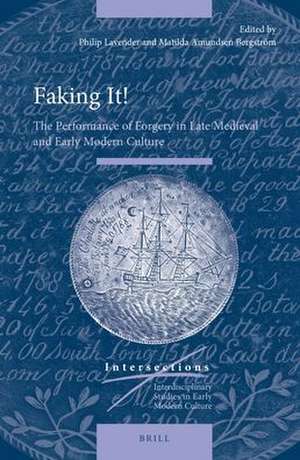Faking It!: The Performance of Forgery in Late Medieval and Early Modern Culture: Intersections, cartea 84
Philip Lavender, Matilda Amundsen Bergströmen Limba Engleză Hardback – 21 dec 2022
Contributors to this volume: Brian J. Boeck, Federica Boldrini, Patricia Pires Boulhosa, Laurent Curelly, Helen Hughes, Jacqueline Hylkema, Philip Lavender, Lorenzo Paoli, Ingrid Rowland, Camilla Russo and Ksenija Tschetschik-Hammerl.
Din seria Intersections
-
 Preț: 215.61 lei
Preț: 215.61 lei -
 Preț: 200.27 lei
Preț: 200.27 lei -
 Preț: 154.86 lei
Preț: 154.86 lei -
 Preț: 192.18 lei
Preț: 192.18 lei -
 Preț: 98.61 lei
Preț: 98.61 lei -
 Preț: 217.51 lei
Preț: 217.51 lei -
 Preț: 116.09 lei
Preț: 116.09 lei - 18%
 Preț: 1074.49 lei
Preț: 1074.49 lei -
 Preț: 241.64 lei
Preț: 241.64 lei -
 Preț: 241.64 lei
Preț: 241.64 lei -
 Preț: 228.96 lei
Preț: 228.96 lei -
 Preț: 229.55 lei
Preț: 229.55 lei -
 Preț: 241.64 lei
Preț: 241.64 lei -
 Preț: 226.67 lei
Preț: 226.67 lei -
 Preț: 107.21 lei
Preț: 107.21 lei -
 Preț: 208.79 lei
Preț: 208.79 lei -
 Preț: 201.78 lei
Preț: 201.78 lei -
 Preț: 226.85 lei
Preț: 226.85 lei -
 Preț: 225.71 lei
Preț: 225.71 lei -
 Preț: 246.63 lei
Preț: 246.63 lei -
 Preț: 228.96 lei
Preț: 228.96 lei - 47%
 Preț: 319.92 lei
Preț: 319.92 lei - 7%
 Preț: 315.66 lei
Preț: 315.66 lei -
 Preț: 96.10 lei
Preț: 96.10 lei - 18%
 Preț: 1201.75 lei
Preț: 1201.75 lei - 18%
 Preț: 659.72 lei
Preț: 659.72 lei - 18%
 Preț: 693.27 lei
Preț: 693.27 lei - 18%
 Preț: 1049.44 lei
Preț: 1049.44 lei - 18%
 Preț: 698.33 lei
Preț: 698.33 lei - 18%
 Preț: 682.00 lei
Preț: 682.00 lei - 18%
 Preț: 687.28 lei
Preț: 687.28 lei - 18%
 Preț: 820.61 lei
Preț: 820.61 lei - 18%
 Preț: 683.39 lei
Preț: 683.39 lei - 18%
 Preț: 667.87 lei
Preț: 667.87 lei
Preț: 670.62 lei
Preț vechi: 817.83 lei
-18% Nou
Puncte Express: 1006
Preț estimativ în valută:
128.34€ • 133.49$ • 105.95£
128.34€ • 133.49$ • 105.95£
Carte indisponibilă temporar
Doresc să fiu notificat când acest titlu va fi disponibil:
Se trimite...
Preluare comenzi: 021 569.72.76
Specificații
ISBN-13: 9789004449480
ISBN-10: 9004449485
Pagini: 400
Dimensiuni: 155 x 235 mm
Greutate: 0 kg
Editura: Brill
Colecția Brill
Seria Intersections
ISBN-10: 9004449485
Pagini: 400
Dimensiuni: 155 x 235 mm
Greutate: 0 kg
Editura: Brill
Colecția Brill
Seria Intersections
Notă biografică
Philip Lavender, Ph.D. (2015, University of Copenhagen) is a researcher at the University of Gothenburg. He is the author of Long Lives of Short Sagas: The Irrepressibility of Narrative and the Case of Illuga saga Gríðarfóstra (2020).
Matilda Amundsen Bergström, Ph.D. (2019, University of Gothenburg) is a researcher at the University of Gothenburg. She has published many articles on early modern women’s writing, such as “Louïze Labé Lïonnoize. The Making of an Early Modern Author” in Renaissance Studies (2021).
Matilda Amundsen Bergström, Ph.D. (2019, University of Gothenburg) is a researcher at the University of Gothenburg. She has published many articles on early modern women’s writing, such as “Louïze Labé Lïonnoize. The Making of an Early Modern Author” in Renaissance Studies (2021).
Cuprins
Acknowledgements
List of Figures
Notes on the Editors
Notes on the Contributors
1 Introduction: The Performance of Forgery
Philip Lavender and Matilda Amundsen Bergström
2 Forgery, Audience and Authentication: Icelandic Agreements of the Fifteenth Century
Patricia Pires Boulhosa
3 All That Glitters Is Not Gold: False Jewellery and Its Juridical Regulation in Italy between the Late Middle Ages and the Early Modern Period
Federica Boldrini
4 Re-Forging a Forgery: The French Editions of Annius of Viterbo’s Antiquitates
Lorenzo Paoli
5 Prenatal Prophecies and Linguistic Ciphers: A Russian Political Forgery Devoted to the Autocratic Evil of Ivan the Terrible
Brian J. Boeck
6 Girolamo Baruffaldi as a Forger: The Case of Barbara Torelli
Camilla Russo
7 The Deceptive Power of a Monogram: Appropriating Dürer’s Identity in the Sixteenth and Early Seventeenth Centuries
Ksenija Tschetschik-Hammerl
8 Mind Your U’s and V’s!: Counterfeiting Newspapers in Civil War Britain
Laurent Curelly
9 The Theatre of Forgery: Curzio Inghirami (Volterra, 1614–1655) and Giorgio Grognet de Vassé (Malta, 1774–1862)
Ingrid Rowland
10 Sailing and Sinking on the Sea of Forgery: The Tradition of Fake Sagas in Seventeenth- and Eighteenth-Century Sweden and Denmark
Philip Lavender
11 Of Theatrical Illusion and Fake Advertisements: George Bickham the Younger, Samuel Foote and the Great Bottle Hoax of 1749
Jacqueline Hylkema
12 Counterfeiting Coins and Convict Transportation from England to Australia in the Eighteenth Century
Helen Hughes
Index Nominum
List of Figures
Notes on the Editors
Notes on the Contributors
1 Introduction: The Performance of Forgery
Philip Lavender and Matilda Amundsen Bergström
2 Forgery, Audience and Authentication: Icelandic Agreements of the Fifteenth Century
Patricia Pires Boulhosa
3 All That Glitters Is Not Gold: False Jewellery and Its Juridical Regulation in Italy between the Late Middle Ages and the Early Modern Period
Federica Boldrini
4 Re-Forging a Forgery: The French Editions of Annius of Viterbo’s Antiquitates
Lorenzo Paoli
5 Prenatal Prophecies and Linguistic Ciphers: A Russian Political Forgery Devoted to the Autocratic Evil of Ivan the Terrible
Brian J. Boeck
6 Girolamo Baruffaldi as a Forger: The Case of Barbara Torelli
Camilla Russo
7 The Deceptive Power of a Monogram: Appropriating Dürer’s Identity in the Sixteenth and Early Seventeenth Centuries
Ksenija Tschetschik-Hammerl
8 Mind Your U’s and V’s!: Counterfeiting Newspapers in Civil War Britain
Laurent Curelly
9 The Theatre of Forgery: Curzio Inghirami (Volterra, 1614–1655) and Giorgio Grognet de Vassé (Malta, 1774–1862)
Ingrid Rowland
10 Sailing and Sinking on the Sea of Forgery: The Tradition of Fake Sagas in Seventeenth- and Eighteenth-Century Sweden and Denmark
Philip Lavender
11 Of Theatrical Illusion and Fake Advertisements: George Bickham the Younger, Samuel Foote and the Great Bottle Hoax of 1749
Jacqueline Hylkema
12 Counterfeiting Coins and Convict Transportation from England to Australia in the Eighteenth Century
Helen Hughes
Index Nominum
